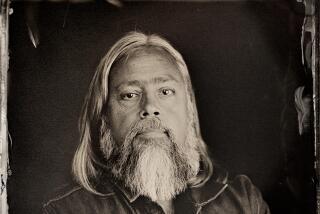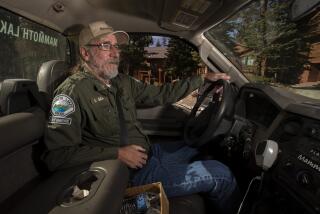A Little Digging Into Prehistory Really Pays Off
- Share via
PORTLAND, Ore. — Twenty-five years ago, Jean M. Auel sat down to write the first threads of an epic prehistoric tale and realized she didn’t know anything about her subject.
She wanted one of her main characters, a young girl, to help a crippled Neanderthal man get a drink of water. The problem was, Auel didn’t know if Neanderthals had cups--and if they did, how they used them.
“How do you get a drink of water? I mean, did she have to take him to the water where he lay down on his belly and lapped it up like an animal or something?” Auel asked.
“I didn’t know what I was writing about. I didn’t know who these people really were. I didn’t know what they looked like, I didn’t know what they wore and I didn’t know where they lived.”
A lot has changed since then.
‘The Clan of the Cave Bear’ Begins Series
Auel’s first fumbling attempts to write a short story “about a girl living with people who were truly different” has evolved into the best-selling “Earth’s Children” series. The volumes are an intricately researched tale set 35,000 years ago, when many people believe early human and Neanderthal societies overlapped.
The series began with the best-selling “The Clan of the Cave Bear,” which tells the story of a 5-year-old abandoned girl taken in by a group of Neanderthals. The fifth book, “The Shelters of Stone,” goes on sale Tuesday with an international release of 2 million copies.
“I sincerely do not know what I’m doing right,” the author said. “I’m writing the story that I always wanted to read. It’s important to do the detail of it, because that’s how you make the story come alive.”
Developing that detail has been a tremendous challenge--and joy--for Auel, 66.
Whenever possible, she draws on fact, using details from tools, skeletons and cave paintings found at prehistoric archeological excavations around the world. But artifacts of stone and bone don’t reveal the intricacies of daily Cro-Magnon life in the harsh climate of the last Ice Age. How did people interact? How did they worship? What did they wear?
Auel had to piece together those details, melding hints from the past with archeological theories and her imagination.
“It’s hints, it’s suggestions, but that’s enough for me to write about,” she said. “There are pieces missing and I have to color them in. I’m not going to put palm trees on top of a mountain. On the other hand, so long as it is within the constraints, I can color that any way I want.”
Nearly 35 Million Copies Sold
Auel’s coloring has paid off handsomely. Her first four books, beginning with “The Clan of the Cave Bear” in 1980, have sold nearly 35 million copies.
Fans already are ensuring that “The Shelters of Stone” will be just as popular. On Monday, it was the No. 3 book on Amazon.com. One advance copy sold for $625 at a recent high school charity auction.
“I think the following that she has now is incredible,” said Barbara Marks of Crown, Auel’s publisher. “There’s something about the characters, and it’s not only stepping into a different world. These characters are just so compelling.”
Auel’s success is perhaps most surprising to the author herself, who recently discussed her life and work during an interview at a hotel in Portland, where she lives. She sipped coffee as she talked, her face adorned with glasses and framed by her reddish-brown hair.
Born in Chicago, Auel married her husband, Ray, just after high school. They moved to Roswell, N.M., and she had five children by the time she was 25. She struggled to rear a family, work and go to night school, first in math and physics, then for an MBA at Portland State University.
Until her first novel, which she completed when she was in her mid-40s, Auel’s only published work was “So You Want to Build a Circuit Board,” an instruction manual she wrote while building circuit boards at Tektronix, an electronic testing equipment manufacturer. She also wrote poetry in her spare time, but didn’t publish it.
“It was never a goal, never a dream for me to be a writer,” she said.
In “The Shelters of Stone,” Auel follows Ayla as she adjusts to living in a human community after years with the adoptive Neanderthals and being on her own. Ayla and her human mate, Jondalar, return to his home in what is now southwestern France, where Ayla struggles to fit in.
The tale unfolds in a 15-mile stretch of the Perigord region, from modern-day Montignac to Les Eyzies, where dozens of caves pockmark a fertile valley. Archeological evidence shows that prehistoric people lived in the shelters of that region--some measuring 10,000 square feet--around the same time during the last Ice Age.
Jondalar, who is 6 feet 6, is based on a skeleton of a young male that was discovered in a nearby cave. He measured 6 feet 5 3/4.
“As soon as I read about him . . . I said, that’s got to be Ayla’s man,” Auel said. “I took a quarter-inch of literary license because it’s easier to write 6-foot-6 than 6-foot-5 3/4.”
In the book, Ayla is the first human to domesticate wild animals, an ability that is mystical to other humans she meets. Her talent delays her acceptance into Jondalar’s community because of fear and suspicion.
Auel used an archeological clue--a carved horse’s head bearing strange markings along the jaw and nose--to develop the idea of domesticating animals.
“Some people say [the carved lines] are stylized muscle structure, but they sure look like a bridle to me,” Auel said. “We’ve got this thing going around the nose, we’ve got a line going up the horse’s head--that’s a bridle. On one of them you can actually see the rope marks carved in.”
Not constrained by the need for scientific rigor, Auel gave Ayla two tamed horses and a domesticated wolf that comes at a whistle, baby-sits small children and knows its name.
Other elements of early life--such as religious and social beliefs--were harder to come by. In some cases, Auel looked to contemporary primitive societies, particularly for inspiration for what Cro-Magnon burial rituals might have been like. In other cases, she was forced to examine archeological records for scant clues.
Auel emphasizes equality between the sexes in “The Shelters of Stone,” often making women powerful spiritual leaders, healers and community leaders. Women participate in almost every daily activity, from hunting to cooking to cave-painting.
The author drew on a study showing that scientists have found an equal number of burial sites for Cro-Magnon women and men, with a slight preponderance for women.
It’s shaky evidence, but it’s enough for Auel to go on.
“Scientists can say, ‘Well, Dr. So-and-So thinks this and Dr. So-and-So thinks that,’ but if you’re writing fiction, characters either do or they don’t,” she said. “You have to make a choice--you can’t have it all.”
Auel worked hard to make her characters and their daily lives seem real. She learned to shape flint tools, weave baskets and mats, tan hides and prepare medicine from wild plants at the Malheur Field Station in the high-desert steppe of central Oregon.
She also participated in a weeklong dig at Laugerie Haute--the so-called Ninth Cave in the latest novel. (She will travel to southwestern France for the novel’s release.)
“I have to live the lives of my characters; I have to make them move in this world,” she said. “You had to be darned intelligent to survive in those days. You had to be intelligent, you had to figure things out, you had to know.”
For the most part, Auel says, archeologists have reacted favorably to her books, even if they don’t agree with every idea.
Doug Kennett, an archeology professor at the University of Oregon, said “The Clan of the Cave Bear” was required reading when he was a graduate student. The goal was to help students understand the importance of telling a story based on research, he said.
“Of course, it’s sort of fanciful. But in certain cases, she captures aspects of what the Pleistocene might have been like,” Kennett said. “As long as it’s grounded in some kind of scientific reality, that’s fine.”
Auel said some archeologists have asked her to write about their excavation sites after reading her books, because even the scientists enjoy thinking about the “what ifs” of prehistory.
“I think that whole period is so much fun,” she said. “I wanted to show that early humans were not stupid . . . that they were not just savage, but that they had some sophistication.”
More to Read
Sign up for our Book Club newsletter
Get the latest news, events and more from the Los Angeles Times Book Club, and help us get L.A. reading and talking.
You may occasionally receive promotional content from the Los Angeles Times.







